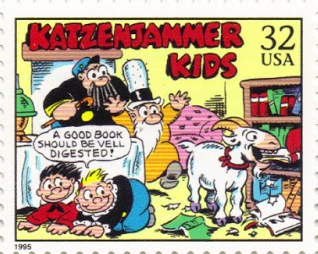
“Katzenjammer translates literally as the wailing of cats (i.e., ‘caterwaul,’) but is used to mean contrition after a failed endeavor or hangover in German (and, in the latter sense, in English too).” — Wikipedia The twins can’t seem to help themselves. They put a tub of water under a bench, saw the bench’s plank in half, cover it with a sheet just for their Ma, wait for her to come to kiss them goodnight, and they don’t warn her not to sit on it, resulting in the inevitable spankings, with them caterwauling like drunks the morning after.
The art director of Hearst’s New York Journal, Rudolph Block, asked Dirks to create the cartoon based on Wilhelm Busch’s “Max und Moritz,” and Block gave the strip its name, so King Features syndicate owned the original title, but the genius of strip was not its name or plot. When Dirks wanted to take a vacation, the syndicate assigned the strip to Harold H. Knerr. Dirks quit, took his vacation, and returned to work for Hearst’s rival, Pulitzer’s New York World, but he couldn’t use the original title, resulting in “The Captain and the Kids.” Dirks, an artist and innovator, popularized speech balloons, speed lines, and comic strip icons such as “seeing stars” and “sawing wood.”
Der Captain is lazy and selfish enough to elicit little sympathy, as he is often the butt of pranks by Hans and Fritz. Dirks showed him no mercy— as a sailor, shipwrecked, and as a father, only a surrogate.
Max and Moritz got their due in rhyming trochaic tetrameter— ground in a flour mill and fed to the ducks. Hans and Fritz, however, the twins, have survived for 123 years so far, with only frequent spankings.